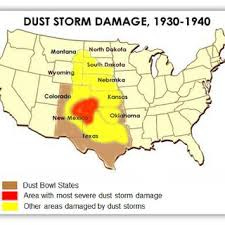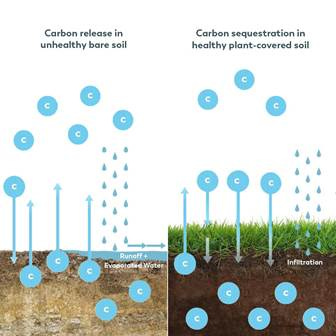Week of July 7, 2025
When this administration came into office, it began, with little thought and less understanding, the dismantling of the federal government as we have known it for decades. Since the beginning of this country, our government has worked, sometimes imperfectly, to keep pace with the problems of the growing populace and the changing environment in which we live. Now, much of that is threatened in ways that it is difficult to imagine or appreciate. For those of you who are new to these essays, my purpose is to shed light on some of the incredibly important, yet frequently unknown, agencies and work of the federal government and to discuss the benefits we have received, even when we are not aware of either the program, its purpose, its work or its successes.
This week, I want to shine a light on a small and critical agency, the Natural Resources Conservation Commission (NRCC), housed in the U.S. Dept of Agriculture. Its mission seems relatively simple on its face:
The U.S. Department of Agriculture’s Natural Resources Conservation Service (NRCS) mission is to deliver conservation solutions so agricultural producers can protect natural resources and feed a growing world. The agencies vision is a world of clean and abundant water, healthy soils, resilient landscapes and thriving agricultural communities through voluntary conservation. (USDA)
And since 1935, it has been doing just that. Working in collaboration and partnership with farmers, landowners, tribes, states, and communities, it provides technical assistance and financial support to help enable us to be better stewards of our nation's soil, water, and related natural resources on non-federal lands. And while its main purpose is to promote better stewardship of our natural resources, one of the important benefits is that when the soil is improved, it sequesters much more carbon, taking it out of the atmosphere and putting it to work for the plants, and ultimately, us. Sequestration reduces one of the key gases, carbon dioxide, which is a major contributor to climate change. Farmers get better yields, reduce the costs of unhealthy fertilizers and the planet, in turn, gets healthier soil to help mitigate climate change. Sounds great, doesn’t it?
The Origin of the NRCS
In started because of one of this country’s greatest disasters: the Dust Bowl. After WWI, millions of acres in the central plains were plowed over and used to grow wheat. But years of overcultivation and poor land management throughout the 1920s, in an area where the average rainfall is less than 20 inches per year, was made much worse when it suffered a severe drought in the early 1930s. The drought lasted several years. Lack of rainfall in this region where farmers had plowed under and ripped out the anchoring native grasses to grow wheat, resulted in a topsoil that simply blew away.
“Black blizzards” of windblown soil blocked out the sun and piled the dirt in drifts. Occasionally the dust storms swept completely across the country to the East Coast. Present-day studies estimate that some 1.2 billion tons (nearly 1.1 billion metric tons) of soil were lost across 100 million acres (about 156,000 square miles [405,000 square km]) of the Great Plains between 1934 and 1935, the drought’s most severe period. (The Dust Bowl)

The Dust Bowl coincided with the Great Depression. FDR was president and, as part of the New Deal, he added an important focus on farmers. The depression and drought hit farmers on the Great Plains the hardest. Many of these farmers were forced to seek government assistance. A 1937 bulletin by the Works Progress Administration reported that 21% of all rural families in the Great Plains were receiving federal emergency relief. Farmers lost their farms and land. Many headed west looking for work in other parts of the country.
And while federal aid began to filter in through various forms of federal action, one of the more consequential forms of federal assistance began as his administration created the Soil Conservation Service (today known as the NSCS). The work of this entity was, and still is, to teach, show and support the transition to soil conservation measures so that the health of the soil dramatically improves which, in turn, promotes better and more sustainable farming practices. Today, these practices are known as regenerative agriculture.
What does the NRCS actually do?
They provide free technical assistance to farmers and private landowners. The staff from the NSCS actually have one-to-one visits with farmers and work with them, individually, to improve the conservation practices. And after a visit, where the NRCS consultant also helps the farmer fill out applications for various grants, the NRCS provides funding to the farmer to implement various recommendations.
One example is Brian Geier and his wife, Elizabeth Tobey, who are farmers in Harrison County, Indiana. They grow corn, soybeans, hay, and flowers on their 55 acres. Last year, they added sheep to the operation. In 2024, they used grant funding to remove invasive trees and brush that had moved into the forested part of their acreage. This year, thanks to a second contract, they were planning to expand their rotational grazing operation with new fencing and water lines. (The Cuts to the NRCS)
Here’s the good news from the work of the NRCS: as farmers and landowners improve their agrarian practices and make the soil healthy and vibrant, it becomes one of the biggest sinks for carbon dioxide; one of the more prevalent and harmful greenhouse gases.
NRCS can help mitigate climate change damage.
The world as a whole produces 41 billion tons of carbon dioxide emissions per year. The vast majority of this comes from the burning of fossil fuels, which includes oil, gas and coal. Our world is heating faster than scientists in the early 2000s thought. NASA provides a great demonstration of how much the globe has heated in less than a century. See this demonstration
The NRCS scientists have a key answer for helping reduce the amount of CO2 in the atmosphere. And when farmers use their methods, it actually saves them money as well. In arid climates, or regions, like the Great Plains with little rainfall, the practices that NRCS espouses, such as no-tillage of soil, cover crops, crop rotation and contour farming, all improve the ability of the soil to take in carbon dioxide:. And with healthier soil, farmers no longer need to spray their crops with fertilizers and other chemicals to produce profitable yields.
Farm land accounts for about 10% of the earth’s soil. Scientists have estimated that soils could sequester over a billion additional tons of carbon each year.(Carbon sequestration) Of course, carbon sequestration in soil won’t solve the entire climate crisis. But soil sequestration removes a huge amount of one key gas we are continually emitting. The more we are able to educate and empower farmers and other landowners to create healthy soil, the more we remove carbon from the atmosphere, we are also improving our own health as fewer chemicals are used to produce the food we eat.
Trump cuts funding for the NRCS
In October of 2024, there were 11,709 employees at the agency, with plans to increase the number to 14,000 by mid-year 2025. This agency is national and the vast majority of the employees were stationed throughout the country in order to be close to landowners and farmers. The Biden administration, recognizing the importance of this work to mitigate climate change, had plans to increase the number of consultants as well as the funding to support the work of farming.
But in the first couple of months of the Trump administration, more than 2,700 employees were let go and all of the new hires were terminated. Right now, the estimates are that about 8,000 employees remain; but much of their budget to do their work continues to shrink as grant money has been taken away. In April, “the U.S. Department of Agriculture announced it was cancelling the Climate Smart Commodities Program — a $3 billion effort to fund projects across the country to improve soil health, sequester carbon, reduce methane emissions and encourage other climate-friendly farming practices. “(USDA Cuts Soil Health Programs)
Across the country, farmers are being told that their work to improve the soil will go unsupported. In Wisconsin, “the loss of the money has resulted in the cancellation of 37 contracts with farmers, 4,000 acres of planned no-till planting going unfunded and, this fall, 16,000 acres of farmland that may not have cover crops planted. “
Why does the loss of the NRCS matter?
You probably never heard of the work of the Natural Resource Conservation Service. Very few of us know about it. Like so many of the smaller agencies that have existed within the federal government, they serve a limited population of clients. Yet the ripple effect of any one of these agencies is huge. Without the technical assistance provided by the agronomists and other consultants providing support for sustainable farming and land stewardship as well as the grants to help cover the costs of transitioning to sustainable practices, we are increasing the harm to our natural resources. Our window to protect our world from the worst of climate change closes more each year. The costs to us all will increase exponentially as our climate warms faster and faster.
The cost to farmers who lose these grants and expert assistance will be passed on to us in ways we may not fully foresee at the moment. Some of the harms we already know. When farmers misuse their land, we lose the protective covering of soil. Droughts are continuing to increase in the same area that hit the Great Plains in the early 1930s. Farms that use non-sustainable methods of farming will lose the topsoil to erosion and drought. We’ve already had one dust bowl—we don’t need another.
Question: Are you familiar with regenerative agriculture, the holistic approach to farming improves soil health, enhances biodiversity, and mitigates climate change.







As with everything you write Andrea, the average person has no knowledge that these organizations exist and what their purposes are. When we saw the movie called “Kiss the Ground“ it totally changed our way of thinking about our interaction with food and soil. It cannot always be just about me, but it has to be about how I engage with the world around me. We all eat and we all expect that there will be food on the table and your article points out one of the many agencies that is necessary to support best practices. Reality is that it is more cost-effective to farmers and therefore to us as well.
Thank you.